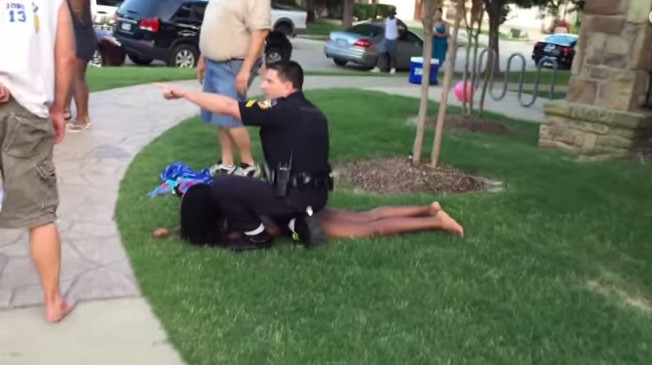Toward the end of many days last summer, with my boys home from camp and still needing to expend their youthful energy, they would run outside and play war games with their remarkably authentic-looking squirt guns. As they roamed the nearby yards and streets in my Waltham, MA apartment complex, I never for a moment feared that someone would call 911 and report them as threatening men with guns, never worried that an arriving police officer might shoot first and ask questions later (if at all).
At the center of the complex is a small community pool to which I’m a member and at which many of the complex’s kids spend a good bit of their summers. It’s an easy walk from my townhouse, and the boys will be old enough this summer that I anticipate sending them down the street to the pool ahead of or even without me sometimes, letting them experience another summertime pleasure that I remember from my youth at the pool near my home. In contemplating this summer plan, I’m not at all concerned that they will be treated as part of a dangerous youthful mob, will have guns drawn on them by overreacting police officers.
That’s how things unfolded this past Friday, at a neighborhood pool in Craig Ranch, a planned community in the Dallas suburb of McKinney. Due to various complicating factors, including the fact that the teens in question were apparently not residents of the community and that the group was mixed-race, the links of this latest police controversy to race are not and likely never will be entirely clear. Yet the cell phone video, capturing a white police officer throwing a bikini-clad African-American teenager to the ground and drawing his gun on two African-American young men, is striking and visceral nonetheless. And it echoes so many videos and stories over these last few years in America.
The McKinney video becomes even more telling when we link it to the case of 12-year-old Tamir Rice, shot and killed by Cleveland police on November 22 of last year. Rice was playing with a BB gun at a playground near his home, and an anonymous 911 caller reported a “male sitting on a swing and pointing a gun at people,” noting that he was “probably a juvenile.” Despite that addendum, and as captured from a playground camera, the police who responded shot Rice within two seconds after arriving and then left him entirely unattended while waiting for paramedics (handcuffing his 14-year-old sister when she arrived and broke down at the sight of her brother in the meantime). Since Ohio is an open-carry state, the attempts to use Rice’s BB gun as justification for the shooting, for any part of this police response, seem particularly unconvincing.
While each individual situation brings its own specifics, the underlying lesson across these two incidents and so, so many others seems unavoidable: In 2015 America, African-American parents cannot possibly send their children out to play without genuine fear for their safety and lives, from the very authorities tasked with protecting them. That last point is particularly horrifying: When Emmett Till was lynched for appreciating a pretty woman, his killers were private citizens operating entirely outside the law. Tamir Rice was killed, the McKinney teens were threatened and manhandled, by representatives of that law.
I, like my sons today, did these sorts of things as a young person: played with toy guns, got out of hand at the pool sometimes, acted like a boy. Being a kid is (or should be) one of our society’s most privileged positions, and there are few privileges of childhood more meaningful than the opportunity to play without worries, to enjoy a summer day on its own relaxed terms. This childhood luxury is becoming painfully, unmistakably intertwined with white privilege.
Ben Railton is an Associate Professor of English at Fitchburg State University and a member of the Scholars Strategy Network.







Thank you. The level of over-reaction and force being used by the police is insane, and it is being directed at African American kids in a way that will cause problems for a long time.
I am still amazed and bewildered by the lack of national fervor over the murder (my words) by police of Tamir Rice.
I saw the video, and there is no world where what they did should have resulted in anything other than criminal charges.
Agreed. To be honest, it seems unavoidably clear to me that if Rice looked like one of my boys, this story would still be a national news headliner today (not that he would have been shot in that case, but you know what I mean).
Thanks,
Ben
Yeah, playing while black is a capital offense for racists.
The police officer did not point his gun and two young men, which would have been bad enough. He pointed at two children.